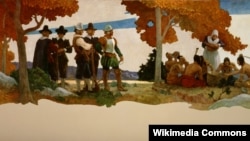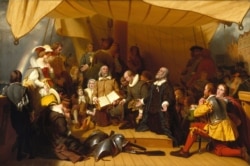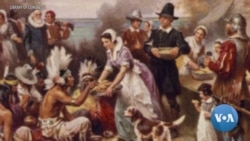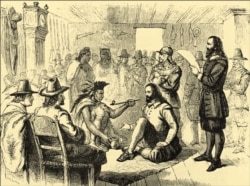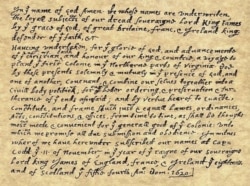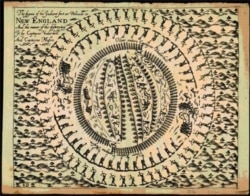In the fall of 1621, English settlers at Plymouth marked their first harvest and began stockpiling food for the winter: cod, bass and other fish, venison, wild turkey and duck that could dried or salted to supplement plentiful Indian corn.
Tisquantum, commonly known as Squanto, was a member of the Patuxet band of the Wampanoag confederation who had learned English from earlier explorers and made himself indispensable to Puritan newcomers.
“Squanto directed us in how to set our corn, where to take fish, to procure other commodities, took us various places for our benefit, and never left us until his death,” Plymouth’s second governor, William Bradford, later wrote.
Now, the settlers prepared to celebrate the harvest and changing fortunes.
Persecuted for their religious beliefs, they’d spent years exiled in the Netherlands, where they worried their culture might be diluted. In September 1620, 102 Puritans and about 25 crew members boarded the Mayflower and sailed to the New World.
“They were encountered many times with crosswinds, and met with many fierce storms, with which the ship was shrewdly shaken and her upper works made very leaky,” Winthrop wrote.
They had intended to establish a farming village in New York’s Hudson Valley, but bad weather forced them to land in Cape Cod in December 1620.
They settled on the ruins of a Patuxet village whose inhabitants had been wiped out by an earlier epidemic. Over the next three months, more than 50 died of cold, hunger or disease. They had little contact with Natives until spring, when Pokanoket Wampanoag chief Ousamequin, whom they called by his title, Massasoit, or “great leader,” requested a meeting.
The two sides negotiated an agreement by which they would live as peaceful partners, a diplomatic arrangement based on balanced land and trade needs.
In their journal, the Puritan leadership described the Massasoit: “In his attire little or nothing differing from the rest of his followers, only in a great chain of white bone beads about his neck,” the journal reads.
The leader wore red face paint and a small bag of tobacco, which he shared with the Puritans, who were so unfamiliar with smoking that they referred to it as “drinking.”
That spring they planted, in summer they tended their fields and built a village consisting of seven houses, a meeting house and three small storehouses.
Now it was autumn and, as did farmers everywhere, including Native Americans, the Puritans gathered to celebrate their good fortune.
Later, Winslow would write a letter to a friend in England, describing what has come to be known as the first Thanksgiving: “Our harvest being gotten in, our Governor sent four men on fowling, that so we might, after a special manner, rejoice together, after we had gathered in the fruits of our labors."
The four hunters managed to kill enough wild turkeys, ducks and other fowl to feed Plymouth for nearly a week, he wrote.
The Wampanoag leader Massasoit and 90 tribesmen joined the settlers for three days of feasting and “entertainment." They brought with them five freshly killed deer as a gift to the governor.
“We have found the Indians very faithful in their Covenant of Peace with us; very loving and ready to pleasure us,” Winslow wrote. “Some of us have been fifty miles into the country by land with them. There is now great peace amongst us; and we, for our parts, walk as peaceably and safely in the woods here as in the highways in England.”
Winslow said now all the colony needed was cattle, horses and sheep, and it would be as comfortable a place to live and work as anywhere in the world.
They only lacked industrious men to come work in Plymouth: “It would grieve your hearts,” he wrote, “to see so much land uninhabited, considering how densely populated parts of England were.”
For several years after that first celebration, relations between the newcomers and the indigenous population remained relatively calm.
But after the settlers incorporated as the Massachusetts Bay Company in 1628, another 20,000 began pouring into the colony, looking for land of their own. Gradually, the company expanded into southeastern Connecticut, home of the Pequot tribe.
The alliance with the Massasoit grew strained over land disputes and the Puritans’ attempts to convert the Indians to Christianity. Tensions mounted after a smallpox epidemic killed half of the Pequot’s 8,000 citizens.
Matters reached a climax in May 1637, when English Puritans, with Mohegan and Narragansett allies, attacked and torched the Pequot village at Missituck (Mystic), Connecticut, killing several hundred men, women and children. Many Natives fled; others were sold into slavery or forced to settle in villages under settler control.
In just two decades, the balance of power in New England had tipped from Natives to English newcomers, heralding two more centuries of warfare and subjugation of the tribes.
The Massachusetts Bay Colony eventually covered much of central New England, including portions of Massachusetts, Connecticut, Maine and New Hampshire.
Today, the federal government recognizes only 10 tribes remaining in New England. According to the 2010 federal census, 37,000 individuals of Native American or mixed Native/European heritage live in Massachusetts. More than 11,000 Connecticut citizens claim part or full Native heritage, 4,000 in New Hampshire and 8,000 in Maine.




